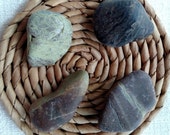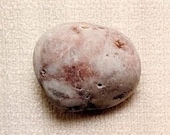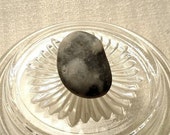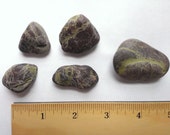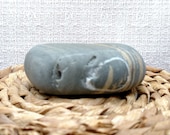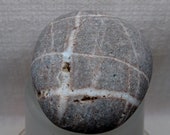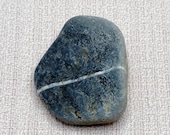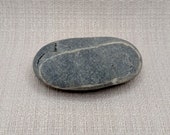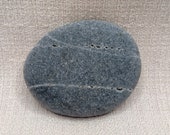Northeast Coastal Granite Beach Stones: A Geological Treasure
When you stroll along the rugged shores of the Northeastern United States, you’re bound to encounter a fascinating world of geological wonders. Among the myriad treasures that the coastline unveils, granite beach stones stand out as sturdy and enduring natural relics. These stones have silently witnessed the eons, shaped by the relentless rhythm of waves and the whispers of time. In this exploration, we delve into the captivating realm of Northeast Coastal Granite Beach Stones, uncovering their unique characteristics, formation, and their remarkable role in the region’s geological history.

The Northeastern coast of the United States, extending from the rocky cliffs of Maine to the serene shores of Long Island Sound, is abundant with granite beach stones. These stones not only offer a glimpse into the geological processes that have shaped the region but also serve as visual and tactile delights for beachcombers. So, let’s embark on a journey through time and earth to understand the story behind these ancient, enduring, and aesthetically striking stones.
Whether you’re an enthusiastic rock collector or simply a lover of nature’s wonders, this article will provide you with insights into the geological gems scattered along the Northeastern coast. So, grab your virtual hiking boots, and let’s start exploring the world of Northeast Coastal Granite Beach Stones.
The Formation of Northeast Coastal Granite Beach Stones
Granite, the bedrock of the Earth’s crust, is an igneous rock formed deep beneath the surface. Its journey to the coastal shores begins millions of years ago. The story of granite’s formation can be traced back to the early stages of the Earth’s development.
1. Magma Generation: The process starts in the Earth’s mantle, where high temperatures and pressures lead to the partial melting of rock. This molten rock, known as magma, is less dense than the surrounding solid rock, which causes it to rise towards the Earth’s surface.
2. Intrusion and Cooling: As the magma rises, it may intrude into existing rock formations. In the case of granite, it’s common for the magma to cool and solidify underground. This slow cooling process allows large crystals to form within the rock, making granite a coarse-grained igneous rock.
3. Exhumation: Over millions of years, geological forces, like tectonic plate movements and erosion, bring granite formations closer to the surface. Weathering processes begin to expose the granite.
4. Erosion and Coastal Transport: As the granite formations continue to move towards the coast, erosion takes place. This process exposes the granite’s surface and eventually releases chunks of granite into the sea. Over time, these granite pieces are tumbled, smoothed, and shaped by the action of waves, forming the characteristic granite beach stones we find today.
Coastal Beach Stones
Distinguishing Features of Northeast Coastal Granite Beach Stones
Northeast Coastal Granite Beach Stones are distinctive in appearance, making them easy to identify. They exhibit several key features:
1. Coarse-Grained Texture: Granite’s large mineral crystals, typically composed of quartz, feldspar, and mica, are visible to the naked eye. This gives the stones a coarse-grained texture.
2. Varied Colors: Granite beach stones come in a variety of colors, but they often include shades of gray, pink, and black. The exact coloration is determined by the minerals present.
3. Speckled or Banded Patterns: Some granite stones have speckled or banded patterns due to variations in mineral composition.
4. Hardness: Granite is renowned for its durability and hardness, ranking high on the Mohs scale. This resilience is why granite beach stones can withstand the relentless pounding of ocean waves over millennia.
5. Subtle Sheen: When polished, granite beach stones often exhibit a subtle sheen due to the light reflecting off the surface of the minerals.
Wishing Rocks
Geological Significance of Granite in the Northeast
The presence of granite along the Northeastern coast holds significant geological importance. Here are a few key points to consider:
1. Witness to Geological Processes: Granite beach stones serve as silent witnesses to the immense geological processes that have shaped the region. They bear the marks of the Earth’s tectonic shifts, mountain-building events, and the forces that gradually exposed them to the surface.
2. Indicator of the Region’s Geological History: The prevalence of granite along the coast reflects the complex geological history of the Northeastern United States. The presence of granite suggests ancient tectonic events that shaped the region, including the collision of continents and the formation of mountain ranges.
3. Erosion and Coastal Dynamics: The process of erosion, which continues today, plays a crucial role in revealing these granite formations. It is a testament to the power of natural forces that continues to shape the landscape.
Spotting and Identifying Granite Beach Stones
If you plan to explore the Northeastern coast in search of granite beach stones, here are some tips for spotting and identifying them:
1. Look for Distinctive Colors: Granite beach stones often have gray, pink, or black colors. These hues are good indicators of granite.
2. Check for Crystalline Texture: Examine the stone’s surface. If you can see individual mineral crystals with the naked eye, it’s likely granite.
3. Feel the Hardness: Granite is a very hard rock. When you tap a granite stone against a piece of glass, it should leave a scratch or show no signs of damage.
4. Observe for Speckled Patterns: Speckled patterns or banded textures are common in granite. These can be strong identifying features.
5. Listen to the Sound: Gently clink two stones together. Granite stones produce a clear, high-pitched sound.
Balancing Rocks – Cairns
Northeast Coastal Granite Beach Stones, with their captivating appearance and rich geological history, offer an engaging entry point into the world of Earth’s ancient processes. As you explore the rocky shores of the Northeast, take a moment to appreciate the enduring beauty and resilience of granite beach stones, true geological treasures that provide insight into the Earth’s ever-evolving story. Whether you’re a geology enthusiast or a nature lover, these stones have much to reveal and share with those who are willing to listen.
Frequently Asked Questions (FAQs)
Are Beach Stones Valuable?
The value of beach stones can vary. Some beach stones, like certain rare or unique granite varieties, can be collectibles or used in jewelry. However, most beach stones are valuable primarily for their beauty and the stories they tell.
What Are Beach Stones?
Beach stones are rocks or pebbles found along the shorelines of beaches. They can vary in size, shape, and type, and many have interesting geological features.
What Are the White Stones on the Beach?
White stones on the beach can be made of various materials, including quartz, limestone, or even seashell fragments. The specific type of white stone can vary by location.
Can Granite Be Stored Outside?
Yes, granite is a durable stone and can be stored outside. It’s often used in outdoor settings like patios and garden decorations.
Can Granite Be Pieced Together?
Granite can be cut and polished to fit together seamlessly. This is often done in construction projects, such as countertops.
Can Granite Be Softened?
Granite is a hard stone and doesn’t soften under normal conditions. It can be cut and shaped using specialized tools.
How Do Granite Rocks Form?
Granite forms from molten rock, or magma, that cools and solidifies deep beneath the Earth’s surface. It’s an igneous rock.
How Does Granite Become Sandstone?
Granite doesn’t become sandstone directly. Sandstone forms from sand-sized mineral grains and may have a different origin.
How Do Beach Groins Work?
Beach groins are structures built perpendicular to the shore to trap sand and prevent erosion. They can help create and maintain sandy beaches.
Where Are Granite Quarries?
Granite quarries are found in various places worldwide, including the United States, India, Brazil, and China. They provide the granite used in construction and decoration.
Should I Buy Granite or Quartz Countertops?
The choice between granite and quartz countertops depends on your preferences. Granite offers a natural look with unique patterns, while quartz is engineered and comes in a wide range of colors and patterns. Both are durable and can be great choices.
Should Granite Countertops Be Smooth?
Granite countertops are typically polished to a smooth, shiny finish, but there are various finishes available, including honed and leathered. The choice depends on your aesthetic preference.
Should Granite Countertops Be Sealed?
Granite countertops should be sealed to prevent staining. The frequency of sealing depends on the type of granite and usage. Typically, they should be sealed every 1 to 3 years.
Why Granite Countertops Are Bad?
Granite countertops are generally considered a good choice due to their durability and aesthetic appeal. However, some concerns may include potential radon emissions (which are usually minimal) and the need for periodic sealing.
Will Granite Go Out of Style?
Granite has been a popular choice for countertops for many years and is considered timeless. However, design trends can change, so whether it goes “out of style” may depend on future trends.
Will Granite Absorb Water?
Granite is a natural stone and is generally not very porous. However, it’s still a good practice to seal granite countertops to prevent any potential water absorption and staining.
Will Granite Ever Run Out?
Granite, like many natural resources, is finite. However, it’s available in large quantities, and with responsible quarrying and conservation efforts, it can be used sustainably for generations.

